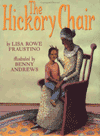|

Kerr,
M.E. 1994. Deliver us from Evie. New York: Harper Collins Publishers. ISBN: 0-06-024476-3.
Evie Burrman is eighteen
years old, strong, and masculine. “You’d say Evie was handsome,” says her brother Parr, whereas mom is pretty.
The family lives on a farm in the small fictional town of Duffton, Missouri where everyone knows everyone and their business too. Despite her mother’s
best efforts to make her dress up, Evie has never been like the other girls. The people in town notice too and being to talk
and pick on her family members about it.
Her family, however, chooses
to act as though Evie’s choice of clothing and personality is just a phase or something they can change. Her father
persists in trying to set her up with Cord the farmhand who is waiting to marry her.
It is not until Patsy Duff,
the daughter of the local banker whose family the town is named after, comes to town that Evie begins to be more confident
about her sexual orientation. Slowly, Evie’s family acknowledges that she is a lesbian, all in their own individual
ways. Evie’s mother still urges her to dress feminine and passes it off as a phase. Her father, who she was previously
very close to, refuses to discuss or acknowledge the matter at all. Her younger brother Parr, who narrates the story, thinks
only of how her coming out will effect him, his relationship with his religious conservative girlfriend, and his future.
Parr had always counted on
Evie staying and running the farm so he could get his education. Prompted by an attempt by Cord and Parr to rouse trouble
and end Evie and Patsy’s relationship, Evie moves to St. Louis to be near Patsy while
she is at school and later to New York City so they can be
together and escape the scrutiny of the onlookers in the small town. While Evie and Patsy are never depicted together in any
scene of the book, it is obvious by the patience they exhibit and the trials they endure to be together that the two are in
love.
A wonderful book, Deliver Us From Evie is full of realistic characters and conversations. Calm, forgiving, respectful, and never
sorry for herself, Evie is a likeable character. The small town’s handling of the situation is realistic as is Evie’s
family’s reaction to the fact that she is a lesbian.
Evie is very “butch.”
Cultural markers describe Evie’s dress and tastes. She wears men’s clothing around the farm and off the farm.
She wears her hair very short or slicked back with a streak of blond. “That was as close as she’d ever come to
makeup.” She walks around with her hands in her pants pockets.
After Evie and Patsy see
a Biker Pike concert together and on Christmas, Mom pops a Biker Pike cassette into the stereo by accident and hears, “They
don't call me Pike/They call me a dyke!/They’re right I’m a dyke,/A dyke on a bike--Biker Pike!” Patsy on
the other hand is very feminine with long blonde hair. Parr thinks she could have any man in the state—the country for
that matter.
The book is powerful and
compelling. As a reviewer for Horn Book Magazine stated, “Kerr explores the
ramifications of being gay in a small conservative community, the varied responses of family and friends, and the complex
relationship between stereotypes and reality. The strong, multi-dimensional, well-plotted story addresses current issues with
sensitivity, thoughtfulness, and a touch of humor.”
1995. The Horn Book Magazine 71 (Jan-Feb no 1): 63. Available from FirsSearch
(database online). Accessed 27 July 2005.
|
 |
|

Rowe Fraustino, Lisa. 2001.
The Hickory Chair. Illustrated by Benny Andrews. New York: Arthur A. Levine Books. ISBN: 0-590-52248-5.
Even though Louis was born
blind his beloved grandmother tells him he has “blind sight.” Gran plays hide and seek with Louis and the older
grandchildren. She is an excellent hider and helps Louis hide too. Though he can’t see the others, Louis can sniff everyone
out. He finds grandmother by tracing her scent of lilacs and bleach. She has a “good alive smell.”
Louis’ favorite time
with grandmother is the time they spend together when she tells him stories in her old hickory chair. One day while at school
Louis’ father comes to give him the sad news that Gran has passed away. At the funeral Louis touches Gran’s hand,
which is “cold and smelled too much of lilacs, not enough of bleach.” After her death, the family gathers to reminisce
and hear Gran’s will.
True to her mischievous ways,
Gran leaves a note for each of her relatives hidden in her favorite things. Louis looks everywhere for his note. Using his
“blind sight” he finds all the notes for his cousins and siblings, but never finds a note for himself. He decides
to keep the hickory chair where his favorite moments were spent with Gran.
Many years later while his
“favorite youngest grandchild” sits on Louis’ lap, she finds the note meant for Louis in the same hole he
had created years before while on Gran’s lap. The note smells of lilacs and bleach reminding him of Gran and her love
for and understanding of him.
Rowe Fraustino employs rich
language invoking imagery and texture of the book, such as the scent of lilac and bleach associated with Gran and her “molasses
voice.” As Jeff Zaleski et al state in a review in Publishers’ Weekly, “Fraustino's uncommonly visual prose, in concert with Andrews's spare yet emotion-filled
pictures, effectively conveys the lasting bond across generations.” The book is beautifully illustrated with oil and
collage. Characters are rendered long and lean with a folk inspiration. “Touches of fabric swatches, such as Gran's
blue petticoat hemline or linen used for the wall of the attic, create a homey atmosphere” add Zaleski et al.
Cultural markers include
Louis’ “blind sight.” Louis uses his sense of smell and sound to compensate for his visual handicap. When
the children play hide and seek, Louis can “almost always sniff everyone out.” When his Aunt Candy-May opens her
purse, “leather and peppermint smells jumped right out. Paper crackled like hickory limbs in the wind…”
Louis’ family is African American. Lois has caramel colored skin and black hair. Gran has gray hair and her skin tone
varies through the story. In some illustrations, it appears to be a coffee color with darker shadows. In others, Gran’s
skin is peach and rose. A strong sense of family prevails throughout the story.
While Louis’
disability is central to the book, it does not become the focus of the story. It is presented in a realistic manner and avoids
stereotypes, but the focus remains on Louis’ relationship with Gran. “Although the boy's blindness features in
the narrative, Fraustino has no interest in romanticizing this disability. The fact that he can't see is simply a detail that
gives the bittersweet story the ring of truth.” said Blake Hume Rodman in Teacher Magazine. The Hickory Chair is a warm story about a boy and
his love for his grandmother.
Rodman, Blake
Hume. 2001. Family Matters. Teacher Magazine 13 (Aug/Sep no 1). Available from Academic Search Premier(database online). Accessed 30 July.
Zaleski, Jeff, Diane Roback, Jennifer M. Brown, and Jason Britton. 2001. Book Reviews. Publishers Weekly 248 (19 February no 8): 90. Available from Academic
Search Premier (database online). Accessed 30 July.
|
 |
|

Nye, Naomi Shihab. 1997. Habibi. New York: Simon and Schuster Books for Young Readers.
ISBN: 0-689-80149-1.
Habibi means “darling” in Arabic. Habibti, feminine for “darling”
is the word Poppy uses to describe his dear Liyana. Her Arabic ancestry is far removed from Liyana, age fourteen, until her
father decides it is time to move back to his homeland, Jerusalem. Liyana who has lived in Saint Louis, Missouri her whole
life is reluctant of the move and while she doesn’t want to hurt Poppy, she has a hard time getting accustomed to her
new home and the members of her family including her grandmother, Sitti, who she is meeting for the first time.
Liyana starts school in the Armenian quarter where she must stuff herself into the tiny
desks and take Arabic classes with the kindergarten students to catch up. She is uncomfortable not understanding the language
and the culture.
Despite her feelings of uncertainty Liyana has a defiant attitude to some of the age
old traditions and tries to buck some of the customs which she feels are archaic. She is glared at by her teacher when she
wears her ring to class, which is considered to be a distraction. She even convinces a fellow student to challenge such rules
by refusing to remove a comb from her hair.
Liyana’s younger brother Rafik has no trouble settling in and quickly is comfortable
with his new home. He and Liyana befriend two young people from a refugee camp close by. Still Liyana misses her friends at
home and thinks about the boy she shared her first kiss with prior to her departure often.
It doesn’t take long however for Liyana to meet a new interesting boy who occupies
her thoughts and time. Omar, who later turns out to be Omer, is handsome and smart. While Liyana assumes he is Arabic, he
turns out to be Jewish. Omer, however, has an open mind and immense interest in learning about Liyana’s family and culture
and proves to be a great friend to Liyana. Her family—Sitti in particular—is fond of him, despite their obvious
differences.
The book moves along at a leisurely, even pace. Liyana’s “first lines of
stories” appear at the beginning of each chapter and set the tone with their poesy. Shihab Nye paints a beautiful picture
of the Middle East—the customs, traditions, the foods, and the people.
In spite of the story’s beautiful connotation of olive trees and ancient biblical
landmarks, Shihab does not avoid the conflict that plagues the Middle East. In one terrifying scene, Israeli soldiers rummage
through Sitti’s house in a search for one of her sons, long out of the country, destroying her bathroom for no reason.
In another Liyana and Rafik’s refugee friend is shot by a soldier and her father is taken to jail for speaking in his
defense.
The story is rife with cultural markers and is a fine example of multicultural literature’s
ability to teach about other cultures through prose. A few examples include the use of Arabic and Hebrew words in the story,
such as booza, or ice cream; maybe, or yimkin; and shalom. Names in the book are Liyana and Rafik. Sitti is the word for grandmother.
Khaled and Nadine are the refugees and Omer is the Jewish friend. Mention of foods such as olive oil, pine nuts, hummus and
baba ghanouj, and warm pita bread invoke the setting. Customs, such as “Arab women don’t wear shorts” are
spelled out in the book.
The women wear, “long dresses…made of thick fabrics, purple, gold and navy
blue, and stitched with fabulous, complicated embroidery.” They all wear bangle bracelets. Liyana’s uncles have
weathered brown faces. The homes are stone buildings with “metal grillwork over the windows instead of screens, flapping
white sheets strung from clotheslines right on the flat roofs…”
As Rosemary Knapp, a reviewer with Book Report stated, “This book is an outstanding
look at what it is like to be a young person in Palestine today. It is rich in detail, personalizes the complex tensions of
the Middle East, and leaves the reader with a sense of hope for peaceful resolutions.”
Knapp, Rosemary. 1998. Book Report 16 (Mar/Apr no 5): 34. Available from Academic Search
Premier (database online). Accessed 1 August 2005.
|
 |
|
|
|

